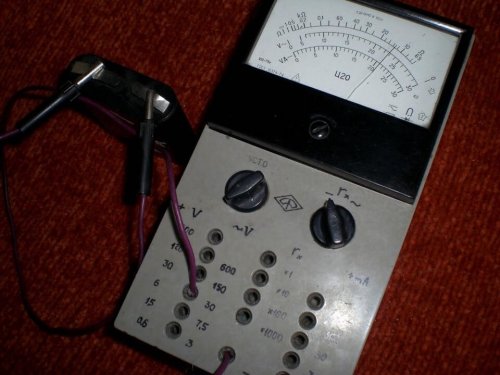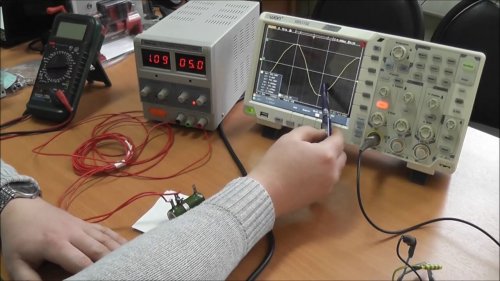How to measure AC and DC voltage
Voltage measurement is not an easy task for an unprofessional electrician, but if you look, it turns out that there is nothing easier (provided that special measuring tools are available). This skill may be needed both for home repair of household electrical appliances or for testing in a single-phase or three-phase AC network, and when working with DC circuits: when checking on a battery with a multimeter or on a car generator, as well as on a computer power supply. To help you figure out how to do this, we decided to write an article on how to measure AC and DC voltage.
How to measure
The main tool here is a voltmeter. It can be made either as a separate device or included in a multifunctional measuring instrument called a digital multimeter.
Digital, because this device has a display to display the values of the measured value and uses digital circuits for measurements (for example, a microcontroller), and not a universal measuring head like old pointer devices. Also, some multimeters are equipped with clamp meters, but they are also used to measure voltage and resistance on a circuit section.
Depending on the specific situation, different measurement accuracy is required. For home purposes, there is no need to buy an expensive and accurate device, so home craftsmen often use a cheap Chinese multimeter (for example, the most popular models are the DT838 or DT830).
Universal measuring instruments are often referred to as a “tester”
For professional purposes, laboratories and repair shops use the most accurate and complex instrument - an oscilloscope. The most popular models of these devices are the Soviet s1-94 and s1-65, as well as the apparatus ads 2061m and foreign type hantek and others.
 Soviet craftsmen usually used a pointer tester or "workshop".
Soviet craftsmen usually used a pointer tester or "workshop".
 Workshop - Ts20 device, a Soviet multimeter designed to measure under load DC and AC voltage up to 600V, DC current up to 750 mA and resistance up to 500 kOhm. Also used devices ts4313, ts4353. The measurements that these devices make are also quite accurate, so some electricians and hobbyists use it to this day.
Workshop - Ts20 device, a Soviet multimeter designed to measure under load DC and AC voltage up to 600V, DC current up to 750 mA and resistance up to 500 kOhm. Also used devices ts4313, ts4353. The measurements that these devices make are also quite accurate, so some electricians and hobbyists use it to this day.
How to measure voltage with a multimeter
Let's start with the basics. By any device, and in any case, a voltmeter is connected in parallel with the element on which the voltage is measured. Any multimeter in voltage measurement mode is a voltmeter. Only an ammeter is connected in series when measuring current.
In cheap multimeters (and in many expensive ones) there are 3 or 4 connectors for connecting probes, usually this:
- COM is a common one, usually black, and a probe is always inserted into it (black, too);
- VΩmA - for measuring voltage, resistance, checking diodes and or small current (up to 200 mA), usually red;
- 10A (20A) - for measuring large currents.
In the figure below you see the most common model of the Chinese multimeter (DT-830 or simply “830th”). The arrows indicate the connectors for connecting the probes, and the connector in which the red probe is to be inserted if you want to measure the voltage is highlighted in green.
In order to measure the voltage in the circuit, it is necessary to perform several manipulations with the device. First you need to determine the type of voltage: constant (DC or sign =) or variable (AC or sign ~), and set the switch to the desired position.
Next, set the measurement limit with the same switch. If on the device it is less than the measured value, then the measurement will not work.
Therefore, the first measurement is made from the maximum limit, gradually reducing it to obtain the value of the desired dimension. For example, if you do not know what voltage in the circuit, set the maximum limit, in the photo shown - 1000 Volts, take a measurement, if it shows “12 Volts” on the screen, then lower the limit to 20V to find out the exact value to tenths or hundredths.
Some devices automatically detect the limit and type of voltage, so switching is not required.
The device is connected to the circuit using probes: one (red) to the plus (or phase), the second (black) to the minus (or zero). If the probes are connected in the reverse order - black to plus and red to minus, then the value on the display will be with a minus.
Measurement Examples
Voltage measurement may be needed in many situations, both in everyday life and in production. Consider the most common of them.
In a household network
With a multimeter in a 220V outlet, measurements are made when it is necessary to understand whether power surges and how much the real value differs from the standard. Deviations of values often occur in unstable networks, especially in small cities and towns. And everyone knows that power surges adversely affect electrical appliances and equipment and can lead to their failure.
 This is also done by detecting an open and open circuit when eliminating various network faults (if the circuit is broken, the voltage will be 0 or close to it) or to determine the phase. The phase search is performed relative to the ground or zero, that is, closing one probe to the ground contact, and the second one at a time to the contacts in the outlet.
This is also done by detecting an open and open circuit when eliminating various network faults (if the circuit is broken, the voltage will be 0 or close to it) or to determine the phase. The phase search is performed relative to the ground or zero, that is, closing one probe to the ground contact, and the second one at a time to the contacts in the outlet.
Knowing the voltage and current strength in the network, you can calculate the power consumption. For this, the formula is used:
P = U × I
In a car
To troubleshoot the battery, the car generator, the starter armature or the ignition coil, as well as the section of the electrical circuit, you need to know the voltage value, so finding a value with a voltmeter or multimeter is also important here. Such a need arises quite often in domestic cars (for example, VAZ 2114, VAZ 2107), but often this must also be done in imported models.
Sometimes it becomes necessary to check the voltage of the linear output of a radio or car amplifier, to diagnose the correct operation. This is usually done by professional automotive electricians. They know that, depending on the model of the radio, the output value can reach from 200 to 5000 milliVolts, the exact data is usually indicated in the passport of the device.
Probe dialing (for example, dmrv - mass air flow sensor) and the diagnosis of the correctness of their work is also performed using a multimeter. To do this, when the engine is running, connect the multimeter to the sensor and compare the readings with the nominal values from the technical characteristics of the corresponding sensor.
For production purposes
For production purposes, measurements are made by professional instruments: a digital oscilloscope. Values from this device are obtained by studying the waveform on its display. This is done at industrial enterprises when diagnosing the correct operation of equipment or manufactured products, in amateur radio practice when setting up and adjusting circuits, and in electronics repair workshops.
 Evaluation of the measured value takes place either with the help of cursor measurements - the cursor is set to a certain point in the waveform and the necessary values are displayed.
Evaluation of the measured value takes place either with the help of cursor measurements - the cursor is set to a certain point in the waveform and the necessary values are displayed.
 But this is available only in digital oscilloscopes, in analog models with a cathode ray tube there is only a coordinate grid on the screen, depending on the installed “volt / division” gain, the number of volts is calculated from the cells of this grid.
But this is available only in digital oscilloscopes, in analog models with a cathode ray tube there is only a coordinate grid on the screen, depending on the installed “volt / division” gain, the number of volts is calculated from the cells of this grid.
 In other areas of production, for example, in construction, it may be necessary to repair various devices. For example, studying the idle speed of a welding inverter can help in its repair, an assessment of the voltage of the battery of a screwdriver can tell about its capacity and wear.
In other areas of production, for example, in construction, it may be necessary to repair various devices. For example, studying the idle speed of a welding inverter can help in its repair, an assessment of the voltage of the battery of a screwdriver can tell about its capacity and wear.
In computers
Evaluation of the correct operation of the USB ports of a computer or charger is necessary in order to know the actual value of the output voltage. This is important for expensive and sensitive gadgets, charging a phone or charging a laptop (for their proper charging and durability).
Also, with a voltmeter, you can measure the voltage in the power supply, and with a device that measures the current strength (ammeter) measure current. A multimeter can also detect the absence of voltage in computer circuits, for example, if there is no minus, then there will be no voltage.
 In special cases, when repairing computer equipment, they check the voltage on the random access memory (ddr2, ddr3), hard disk, display cable or power supply.
In special cases, when repairing computer equipment, they check the voltage on the random access memory (ddr2, ddr3), hard disk, display cable or power supply.
Also, when repairing computer microcircuits (and not only, for example, on an arduino), the device tests the voltage of the capacitor, resistor, at the poles of the current source, the stabilization voltage of the zener diode, and so on. All these measurements require certain knowledge and skills, therefore they are made by professional device repairmen.
So we figured out how to measure the voltage of direct and alternating current. It is extremely simple to do. A voltmeter or multimeter is always connected in parallel to the circuit. With a serial connection, this will not be possible, because the voltmeters have a large internal resistance and simply no current will flow through it.
Related materials:














